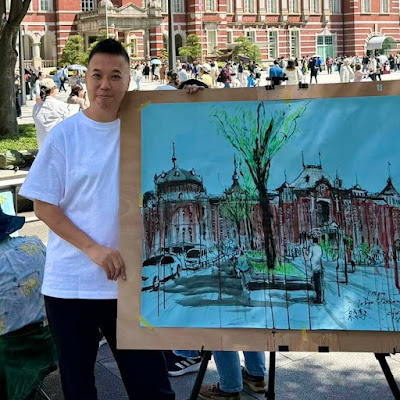Meet Your USkJ Friends Interview: Boonhau

USkJメンバーをインタビュー形式で紹介するシリーズ、Meet Your USkJ Friends。今回フィーチャーするのはマレーシア出身のBoonhau(愛称はハオ)くんです。彼も以前紹介したニア(Lavinia)やわたしと同世代で、現在は東京の大学院で建築を学んでいます。USkJには2018年10月原宿でのスケッチクロールからの参加。わたしもその場にいましたが、みんなで原宿駅をスケッチしているところハオくんが「アーバンスケッチャーズですか?」と声をかけてきたこと、それから途中参加で、あの解体が予定されている趣深い木造の旧駅舎をあっという間に描き上げ、みんな驚いたことをよく覚えています。建築を学んでいることもあり、複雑な建築構造や込み入った通りの景色を捉えるスキルはさすが。インタビューの最後に建築を描くコツについても聞いているので、ぜひ最後までお楽しみください:)(今回も英語で行ったインタビューに日本語をつけています。完全な翻訳ではありません。)
Here’s a new episode of Meet Your USkJ Friends, a series of interviews with USkJ members. This time I interviewed Boonhau (Hau) from Malaysia. He is the same generation as me and Nia, who is featured in a previous episode, and now studying architecture at a grad school in Tokyo. He joined USkJ in October, 2018, when we had a sketchcrawl in Harajuku. I remember well that he suddenly asked us if we were urban sketchers while we were sketching Harajuku Station and then surprised us by quickly and amazingly drawing the old wooden building of the station, which is to be demolished now that the new building has opened. As he is an architecture student, he has the great skill of capturing intricate architectural structures and busy street scenes. I asked a question about tips of drawing architecture in this interview. Hope you enjoy reading:)
---------------------
1: When did you start sketching? How did you get involved in the USk community?
スケッチを始めたのはいつ?またUSk参加の経緯は?
I started to sketch when I enrolled in architecture around 7 years ago. Before that I knew nothing about sketching. During that time, I do it mainly for the purpose of course work. I can’t remember why it suddenly became my hobby. But, vaguely is one of my friends who influenced me. I knew USk community when I was studying, but I never joined the sketching group until I started to work. It was through a Facebook event for me to get involved with the sketching community. It takes me some time and courage to really go out and sketch with some many people that I don't know at all. But, it is a good way to spend my weekend.
(7年くらい前に建築を学びだしてからスケッチを始めました。それ以前はスケッチのことは何も知りませんでした。当時は主に授業の一環でスケッチをしていて、それがどうして突然趣味になったのかは覚えていませんが、たぶん友人に影響を受けたためだと思います。学生時代からUSkは知っていましたが、働き始めるまで参加したことはありませんでした。グループに入るようになったのは、Facebookのイベントを通じてです。まったく面識がない人たちと出かけてスケッチをするようになるには、ある程度時間と勇気が必要でした。でも、それも今ではいい週末の過ごし方になっています。)
 |
| 新宿、中井/Nakai, Shinjuku |
2: What do you like to sketch (people, architecture, nature, etc.)?
何をスケッチするのが好き?(人、建築、自然等)
Even though I study architecture, I prefer to sketch people more than building. Small buildings probably yes but I usually avoid sketching big buildings because it is out of my control. People are best because the second moment you raise your head and try to check how to continue next it will change to a different pattern, so you have to either do it very fast or play with it with your own imagination. It’s challenging. I like to sketch a very compact scene with many things here and there, I feel it is worth it for me to spend several hours just checking it and drawing. Also, I like line drawing, so if I find nothing to sketch I will turn to electric posts.
(建築を学んでいますが、建物よりも人を描くのが好きです。小さな建物はまあ、いいですが、大きな建物は手に負えないので描くのを避けています。人が一番おもしろいです。顔を上げ、どう描き進めていくか確認した次の瞬間には、違う動き・形(pattern)をしているので、とても素早く描いてしまうか、想像力で補って楽しむかしないといけません。人を描くのはチャレンジングです。それから、ここそこにいろんなものがぎゅっと詰まった景色が好きで、そういった景色をただ見て、描くだけに何時間も費やせてしまいます。線画も好きなので、何もスケッチするものがないときは電柱を描いています。)
3: Show us your favorite sketch done in Japan and tell us about it.
日本で描いたスケッチでお気に入りを紹介して。
I am interested to Japanese traditional streets. They are compact and full of attractive elements. These drawings were drawn in Shibamata. Each shop comes with different contents, so I want to capture them as a series of drawings.
(日本の古い通りに興味があります。こじんまりした中に、目を引く要素がたくさん詰まっています。これらは柴又で描いたスケッチで、お店ごとに異なる品を扱っているので、ひと続きのスケッチにすることでお店(の魅力)を描くようにしました。)
4: Name your favorite sketcher(s) if any.
好きなスケッチャーを教えて。
I don’t know much about other sketchers, but from those who I meet before:
Kiah Kiean from USk Penang
I like his drawing stroke and the way he combines ink with tree branch to draw.
(あまり他のスケッチャーのことを知りませんが、会ったことがある人から選ぶと、USkペナンのKiah Kieanです。彼の筆運びと、インクと木の枝を組み合わせて描くスタイルが好きです。)
5: Show us your sketch kit (sketchbook, pen, watercolor, etc.) (Please attach the photo of it.)
スケッチキットを見せて。(スケッチブック、ペン、水彩等)
I mainly use pen to sketch, sometimes a little bit of color.
(主にペンで描いていて、たまに少しだけ色を使います。)
(訳注:昨年10月ファーバーカステルとのコラボイベントで同ブランドからご提供いただいたペン等を使ってくれています!)
6: What has urban sketch brought to your life?
アーバンスケッチがあなたの暮らしにもたらしたものは?
It allows me to travel in a different manner. When I travel alone, people will come and talk to me while I am sketching, so I got the chance to talk with local people easily even though I don’t know their language. In another way, I get to know more people with it. I don’t take pictures much, so sketching has become my way of memory recording. For me, able to draw in the street is not an easy task to begin with, because so many strangers will look at me and I will feel shy, but it is no longer an issue now. I can say I gain some confidence from here.
(旅のあり方を変えてくれます。一人で旅しているとき、スケッチしていると声をかけられることがあり、そうすると現地の言葉がわからなくても、そこの人々と簡単にやりとりすることができます。また、スケッチを通して、より多く人のことを知ることができます。あまり写真を撮らないので、スケッチは僕にとって思い出を残しておくための手段になっています。はじめは、見知らぬ人に描いているところを見られると恥ずかしいので、通りで描くのは簡単ではありませんでしたが、今ではもうそれは問題ではなくなりました。自信がついたんだと思います。)
 |
| 浅草/Asakusa |
7: You always capture architectural structures amazingly. What should we focus on when drawing them?
いつも建築物の構造を捉えるのが見事だけど、建築を描くときは何にフォーカスしたらいい?
It comes with scale, proportion and perspective but for me it doesn't need to be perfect and accurate as long as it makes you feel good. I will suggest trying to look at the outline or profile of the architecture you want to capture. It makes it easy to figure the overall image on how to present it. Distorting it as much as you like if you feel it is difficult to draw it perfectly. I think it is more fun and probably you might find your own way of representation. I usually separate what I saw into several layers then draw them layer by layer. But when I am lazy, I only focus on one part of the building then I will extend the rest out of it, this method allows me to show the contrast easily at the same time it looks finished even if it is not finished actually.
(建築にはスケール、プロポーション、パースペクティブといった要素が絡んできますが、僕にとっては自分がいいと思えれば完璧に正確である必要はありません。描きたい建築物の概観や輪郭を見るようにするといいと思います。そうすると、どう描くかの全体的なイメージを掴みやすくなります。正確に描くのが難しいのであれば、好きなだけ歪めるのもありです。そのほうが楽しいと思うし、自分らしい表現の仕方が見つかるかもしれません。僕はだいたい自分が見ているものをいくつかのレイヤーに分け、そのレイヤーごとに描いていきます。でもめんどくさいときは、建物の一部分にだけフォーカスして描き、そこから残りの部分に広げていきます。こうすると簡単にコントラストがつけられ、完成していない絵も完成しているように見えます。)
 |
| 渋谷/Shibuya |
---------------------
最後の建築の描き方、とても参考になりますね~!ハオくんのスケッチはいつもスケールやパースペクティブがしっかりしていますが、それは写真のように完全・正確ではなく、人の手で描いているからこその歪みや遊びがあって、スケッチにダイナミズムのようなものを生んでいます。どうやったらそんなふうに描けるの?と思っていた方も少なくないかと思いますが、今回教えてくれたコツをもとに描いてみると発見があるかも(わたしも試そうと思います)。インタビューシリーズはまだまだ継続の予定です。こちらからご協力のお願いをさせていただく可能性もありますし、インタビューに答えたいという方がいましたらぜひブログ執筆者までお声かけください。それではまた次回の投稿で。
His answer to the last question (tips of drawing architecture) is quite helpful, isn’t it? The scale and perspective in his drawings are always great, but they are not completely accurate (accuracy is not necessarily important as he said) and instead there are twists and distortions, which bring the drawings dynamism. I believe many of you wonder how one can draw like that. You can try the methods he introduced here (I’ll do that too). We will have more interviews with other sketchers. We might ask you to have one in the future. Also let us know if you want to take part. Thanks for reading. See you in the next post!







Comments
Post a Comment